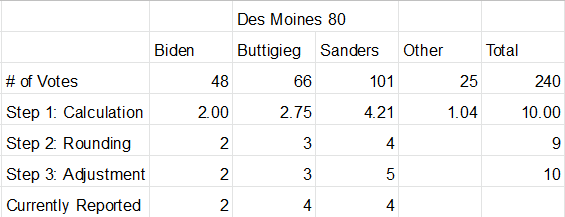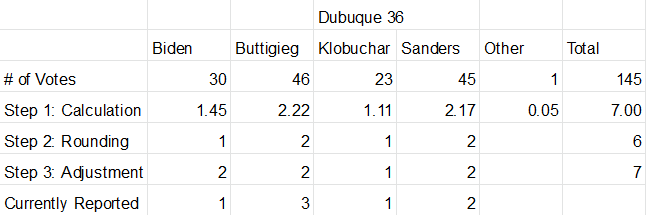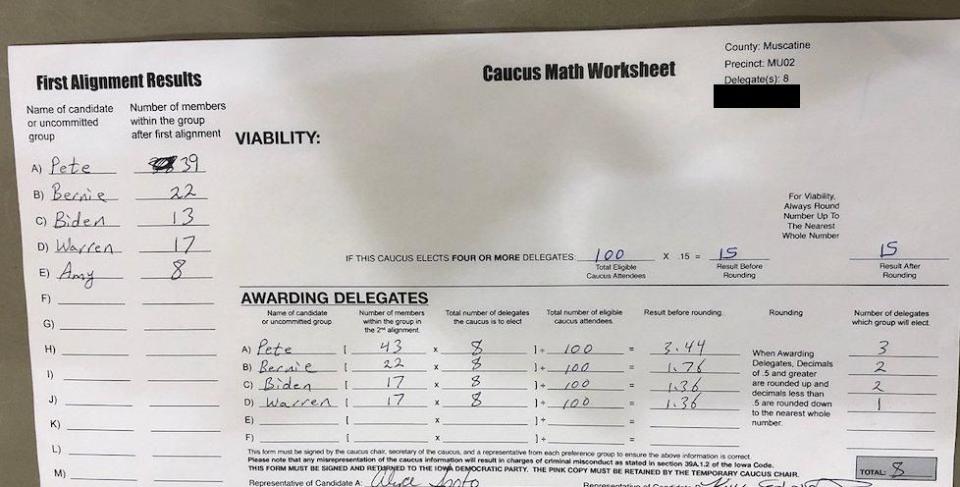The Iowa Caucuses Were a Mess and Here's The Math to Prove It

🚨UPDATE 2/19/20: The Iowa Democrats have published another update to their caucus data. They reviewed dozens of precincts at the requests of the Buttigieg and Sanders campaigns, including all four precincts we discussed in this article, which are now fixed. The margin between Buttigieg and Sanders has officially shrunk to .08 State Delegate Equivalents, which is .0004 percent. That difference is roughly the weight of a single delegate at a single precinct. An additional wave of recounts may be conducted before the Iowa state convention. With the margin now incredibly close, this story may still not be over.
***
The first Democratic presidential primary of 2020 happened Monday night in Iowa. Five days later, we still don’t actually know who won. While the percentage of reporting precincts has slowly crept toward 100 percent this week, we aren’t there quite yet—but the journey has been a mess riddled with mathematical errors.
Thursday night’s last update went to 99.9 percent reporting, and shows Senator Bernie Sanders winning the popular vote by over 2,000 votes, with Mayor Pete Buttigieg capturing the State Delegate Equivalents (SDEs) by less than 0.1 percent. This razor-thin margin will translate to Sanders and Buttigieg getting equal delegates from Iowa to the national Democratic convention, so in that sense, they’ve tied. (By all measurements, Senator Elizabeth Warren took third place, while former Vice President Joe Biden came in fourth.)
One of the main causes for the delay in results, according to the Iowa Democrats, was a reporting app that was not adequately tested before the caucuses. With the commotion of these technical difficulties, the entire usual timetable has been so pushed back that some basic, embarrassing math errors have slipped by, according to the standards for delegate math laid out by the Iowa Dems. It’s our job to point those out.

Delegate Math
There are three steps to the delegate math: calculate, round, adjust.
First is a calculation for each candidate. It’s (number of voters that candidate got)*(number of delegates at stake)/(total voters at the caucus), which gives the raw number of delegates that candidate earned, typically not a whole number.
Second is rounding. There’s nothing tricky at this step—just round up if the decimal is 0.5 or higher, and round down otherwise.
After rounding, the candidates’ delegate counts may not add to the total delegates at stake. That calls for an adjustment step.
If several candidates were rounded down, their delegate counts might add up to less than the intended total. The spare delegate is then given to the candidate who was closest to their next delegate—essentially, the one who got rounded down the farthest.
Similarly, the other way, if rounding makes the total go too high, then a delegate is taken back from the candidate who got rounded up the farthest.If two candidates are tied at the adjustment step, then a coin is flipped to see who gains/loses the adjustment delegate. That’s the only time coin flips are supposed to happen.
The Errors
Des Moines Precinct 80 has already received heavy attention, centering on this tweet and video from that day:
Des Moines Precinct 80:
Bernie’s group had 101 people
Pete’s group had 66 people
Bernie & Pete end up tied at 4 delegates following a coin toss.
This is democracy??? 🤔#IACaucus pic.twitter.com/g9q1k67Vpn— Jaylen (@jaylencavil) February 4, 2020
Before precinct data was published, the tweet might’ve been explained by some sort of miscommunication. Now that data is officially out, it confirms the numbers in the tweet: Sanders had 101 voters and Buttigieg had 66 on final alignment, but both received 4 delegates.

The full picture painted by the data is 101 votes for Sanders, 66 for Buttigieg, and 48 for Biden, plus 25 uncommitted voters, for a total of 240. Delegates were officially distributed 4-4-2 for Sanders-Buttigieg-Biden. But that should have been 5-3-2.
Why? Because after the first calculation step, Sanders had 4.21, Buttigieg had 2.75, and Biden had 2.0. These round to 4, 3, and 2, respectively, which add up to 9. The precinct had 10 delegates to give out, so it needed to give the final delegate to the candidate closest to their next delegate.
At 0.79 away from his fifth delegate, Sanders was closer than Biden, who was 1.0 away from his third delegate, and Buttigieg, who was 1.25 away from his next fourth delegate. The tenth delegate unequivocally should have gone to Sanders.
Another apparent math error is in Dubuque Precinct 36. Its published numbers show final vote counts of 46 for Buttigieg, 45 for Sanders, 30 for Biden, and 23 for Amy Klobuchar, plus 1 voter who left or remained uncommitted.

Initial calculations yield the numbers 2.22 for Buttigieg, 2.17 for Sanders, 1.45 for Biden, and 1.11 for Klobuchar. After rounding, that’s 2, 2, 1, and 1, which add up to 6. The precinct had 7 delegates to give, so it had to give its last delegate to the candidate who got rounded down the farthest: Biden.
But the official report for Dubuque 36 shows it gave 3 delegates to Buttigieg and 1 to Biden. That was a mistake.
Next, let’s look at Muscatine Precinct 02. We have a nice firsthand glimpse into this precinct thanks to its caucus math sheet posted online by a journalist:

From the picture, you can see the step 1 calculations yielded 3.44 for Buttigieg, 1.76 for Sanders, 1.36 for Biden, and 1.36 for Warren. These round to 3, 2, 1, and 1, which add to 7, which is 1 less than the 8 delegates the precinct had at stake.
The correct adjustment would have been to Buttigieg, since he was closest to his next delegate. But, perhaps excited at the rare prospect of a coin flip, the precinct captains that night apparently thought they needed to flip a coin between Biden and Warren, which landed in favor of Biden.
Perhaps under normal circumstances this error would have been detected and fixed. Instead, it’s the end of the week, and Muscatine 02 still officially shows 3 for Buttigieg and 2 for Biden, where it should be Buttigieg with 4 and Biden with 1.
Finally, check out Guthrie Gold precinct.

This precinct had 14 delegates at stake, and its reported final votes were 13 for Biden, 13 for Buttigieg, 13 for Klobuchar, 11 for Sanders, and 10 for Warren. Those calculate to 2.94, 2.94, 2.94, 2.48, and 2.26, respectively, and round to 3, 3, 3, 2, and 2, which add up to 13. That’s short of 14, so an extra delegate must be dished out.
If you’re getting used to this, you can probably spot that the last delegate belonged to Sanders, who, at 2.48, had been rounded down the farthest. Apparently that was overlooked at the time, and a coin was flipped between the three candidates who had already been rounded up, ending in favor of Buttigieg.
The official results for Guthrie Gold, as of this piece’s publication time, still show 4 delegates for Buttigieg and 2 for Sanders, whereas both should have 3.

How Does This Add Up?
The four mistakes we’ve just highlighted have helped and hurt a mix of candidates. Three of them helped Buttigieg, while one hurt him. Biden broke even with one positive and one negative, and Sanders was hurt twice.
Fixing these errors alone will thus have a net impact of raising Sanders’s SDE total while lowering Buttigieg’s. It will be a fraction of a delegate, but at the current margin of SDEs between them, that will be substantial.
Moreover, this was not exhaustive. We’ve stuck to the precincts where the numbers are fully published and clearly erroneous. Many other precincts have been plagued by the relatively simpler issue of numbers input into wrong columns—a problem the Iowa Dems have been methodically fixing.
To some extent, it’s routine to have a few stray math errors among thousands of people coordinating weird calculations in one day. This time, the errors seem to be lingering. They also have a unique impact given the closeness of the SDE count.
These errors, along with the others out there, ultimately could change who wins the SDE total. Either way, that number is an intermediate between the popular vote, which was won by Sanders, and the national delegate count, which is a tie between Buttigieg and Sanders.
We’ll continue to monitor as the Iowa Democrats fix these mistakes.
You Might Also Like

